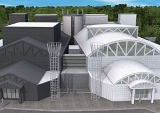 A new museum honoring the memory of the millions of Jews and rescuers killed during the Holocaust opens this weekend in Chicago. The Illinois Holocaust Museum and Education Center is located in Skokie. This morning, religious leaders from the Chicago area toured the museum during an interfaith breakfast. The largest museum of its kind in the Midwest, it opens to the public Sunday.
A new museum honoring the memory of the millions of Jews and rescuers killed during the Holocaust opens this weekend in Chicago. The Illinois Holocaust Museum and Education Center is located in Skokie. This morning, religious leaders from the Chicago area toured the museum during an interfaith breakfast. The largest museum of its kind in the Midwest, it opens to the public Sunday.
Among those who attended the opening was President Bill Clinton.Thousands of survivors live in the Chicago area. Many spent more than a decade working to establish the holocaust museum.
For some, World War II may seem like it happened a lifetime ago. But for those who survived the Holocaust, the details of that time are as clear as if they happened yesterday.
ABC7 spoke with one survivor who hopes this museum will help ensure it never happens again.
“I’m consumed with hate because hate is all I can feel and yet, I’ll show them I’ll survive,” reads Aaron Elster.
A sea of eighth graders listen intently as Elster reads from his memoirs. They each have read his work as a classroom assignment.
“It haunts me in a way that that could happen to my family,” said Helena Igbo, JFK Middle School.
“I think it’s very important for kids to know the history, so they can tell their kids and those kids can tell their kids,” said Derek Smith, JFK Middle School
And that is why Elster speaks at schools about twice a week and has poured the last fifteen years of his life into helping create a legacy — the Illinois Holocaust Museum and Education Center in Skokie.
“It must be continued because we’re disappearing. In a few years, there’s not going to be any survivors left,” said Elster. “This place has a lot of significance. It will live on a lot longer than we will.”
Elster’s father and six-year-old sister, Sarah, where killed at the Nazi concentration camp Triblenka. His mother made a deal with a farmer for her own safe haven. The ten-year-old was left on his own. A Polish couple was hiding his older sister, Irene. He convinced them to take him in too.
“It turned out to be close to two years I stayed in that attic. Never ventured outside, not even once. Never changed my clothes, never took a bath, cut my hair, brushed my teeth. My preoccupation was to rid myself of the lice that I was infested with,” said Elster.
Like many survivors, Elster says he didn’t want to tell his story when he was younger. Now, he feels compelled to do so.
“Because if not us, then who? Because the killings are still going on. If it’s not the Jewish people, it’s other people. It’s not just the Holocaust. It’s genocide,” said Elster.
Elster hopes at least a quarter of a million students will visit each year, experiencing its poignant artwork and interactive children’s center. They can even see a real railcar like the ones that were used to transport Jews to concentration camps and certain death.
“It’s a place where we can talk about what words do, to try and get people, young people not to be bystanders, to become active to help change this world for the better,” said Elster.
The museum’s Hall of Remembrance bears first names of people who perished. It serves as a personal memorial for Elster.
“I believe that a soul travels until it finds a resting place and I believe my parents’ souls, my little sister are here. It’s a place where I can come to and pay my respects to them, tell them how much I miss them, what my life was like and what my life is now. I want them to be proud of me,” said Elster.
{WLS-TV/DT/Matzav.com Newscenter-Elisha Ferber}











